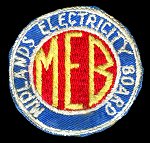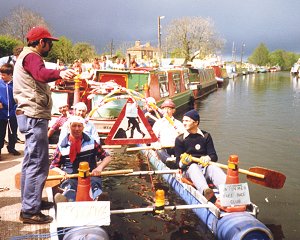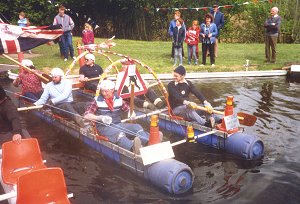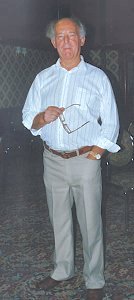 |
Work and Leisure at MEBby Neville Baker |
 |
| I joined the Midland Electricity Board as an apprentice electrician in April 1950. Immediately after completing my apprenticeship I was conscripted into the RAF to do my two years of national service, mainly at South Cerney in Gloucestershire, working on electrical maintenance of helicopters and Chipmunks. After demobilisation I resumed working for the Midland Electricity Board and was eventually offered the opportunity of a move from Banbury to the Wolverhampton branch based at Clarence Road. I took up the offer and moved in September 1958. |
 |
This is a woven badge, showing the earliest version of the MEB logo, which I have kept from my early days there. | It turned out to be a wise choice because I very
quickly settled down. I made many friends at the workplace and I
joined in the numerous social activities available to all
employees, especially the excellent facilities provided by the
firm's Wolverhanpton Electricity Sports and Social Club. Before
long I was fortunate enough to be invited to become a committee
member and later was elected chairman and, finally,
vice-president.
For most working people the fifties was a period when their entertainment comprised mostly of membership of a works social and sports club, going to the cinema or theatre, ballroom dancing, going to a football match or speedway meeting or, in the summer, playing tennis, cricket or bowls. |
At the beginning of 1960 new offices and workshops were starting to be built on a selected site in Major Street, Wolverhampton. In the first week of January 1961 the office staff who operated from premises in Red Lion Street, just around the corner from the main MEB contracting buildings in Clarence Road, moved into their newly built quarters in Major Street.
It took a little longer before the Stores and Workshops were available for occupation by the contracting and service office staff but, eventually, in 1962 the transfer of the whole district organisation was completed and the historical Midlands Electricity Board, Wolverhampton Area, District Office, Major Street, came into being. One great difference was the modern, bright canteen which, for the first time, allowed both manual and office employees to share the same facilities. Alongside this was a well kept bowling green for the use of anyone interested during the lunch hour break or after finishing work in they so desired.
There was always an active bowling team that competed in the local leagues, a cricket eleven and the opportunity to play for the works football team. In addition there were always regular works outings, Christmas parties and frequent social gatherings for the management and workforce to enjoy together.
The employees even built their own raft in the eighties to compete in the local boat rallies and contests held on canals near to Wolverhampton as the is evident from the various photo shots. Mainly the team entered for charity purposes.
 |
The notice on the front of the raft proclaims: "Wton MEB Raft Race Club" and this is us on the canal at Wobaston, sometime in the early 80s. On the embankment is the team leader, Martin Hadfield. There are six in the raft and they include Ken Murray, Barry Fletcher, Malcolm Cadwallader - and that's me in the middle row on the right. |
 |
There seems to have been some problem about getting away from the bank ... |
 |
... but we got going and ended up in the lock.
We were the winning team on the day! |

| Me in retirement, at a meeting of the Black Country Memories Club. |
Shortly after the move I was made foreman, working with colleagues such as Tom Brewin, Jack Wall, Harry Hodgkins and Derek Blount. Then I finally, in 1964, attained the position of construction engineer in, working with John Mossford and helping out with contracting and the service office.
When the privatisation of the electricity industry-became a distinct possibility I became involved with a locally instigated campaign to fight the proposed sale, becoming chairman of a combined group of people drawn from the workforce. Before long we joined forces with members of various residents, tenants, senior citizen and community-groups, all similarly concerned about the likely detrimental effects of wholesale privatisation.
Over a period of many months we held numerous joint meetings, organised public debates, distributed leaflets, conducted a hectic campaign of letter writing to a selection of ministers and members of parliament of each party, and also carried out a long session of exchanges through the letter columns of local newspapers.
| In the end it all failed to prevent the inevitable
sell off and the rest is history, as they say. But at least we put
up a spirited fight to make known our doubts about the entire
concept of privatisation.
In 1992 widespread redundancy spread through the industry and thousands of staff were released; and very soon even the very name MEB was to disappear under an ever widening of policy of amalgamations and take overs. The once busy sight of the district electricity offices of Major Street, that successfully served a vast area of consumers with all their essential electricity needs, is now but a sorry collection of dilapidated buildings. That makes it all the more important that its past contribution to the social history of the Black Country area it once served should not be overlooked or forgotten. |
More on The MEB click here to go back to the MEB front page click here to return to Industry front page